Abstract
Effective water resource management requires an understanding of the interactions between water and environmental parameters, especially in regions with limited data availability. This study used generalized additive models (GAMs) to investigate the relationship between climatic and hydrological factors, namely river flow, rainfall, air temperature, and physicochemical water quality parameters in the Kiso River, Japan. Seasonal and non-seasonal GAMs models were developed for each water quality parameter, resulting in 7 non-seasonal models and 28 seasonal models based on Japan’s meteorological seasons (winter, spring, summer, fall). The findings demonstrated how seasonal models captured seasonal variability, significantly outperforming the non-seasonal models. For example, turbidity in winter (R2 = 0.5030) showed significant improvement compared with non-seasonal models (R2 = 0.1470), and organic pollution in fall (R2 = 0.4099) increased compared with non-seasonal models (R2 = 0.2509). Beyond assessing the influence of environmental drivers on water quality, these findings are crucial in regions with limited data, emphasizing the role of model–based seasonal analysis in identifying high-risk contamination periods, and supporting targeted and effective water management and early warning systems.
1. Introduction
Water quality monitoring plays a critical role in environmental protection and the sustainable management of water resources. Its importance has expanded to include the health of aquatic systems, biodiversity protection, and human health. River water is used for domestic, agricultural, and industrial purposes and is influenced by a combination of natural and anthropogenic factors, with significant contributions from agricultural activities [1,2,3], industrial pollution [3,4,5], and urban development [6,7,8], including the impact of climate change [9,10,11].
Water quality parameters are often interrelated and can fluctuate depending on the environmental conditions. Increasing temperatures affect water quality, reduce dissolved oxygen (DO), affect the physiological processes of aquatic organisms, and influence various biogeochemical cycles [12,13,14,15]. A study conducted in Tianyin Lake, Shangzhi, China, found that increasing temperatures decrease the DO levels in water; while concentrations of ammonia, nitrate, total nitrogen, COD, and phosphate increase [16]. Similarly, a study has also shown that expected increases in nitrate, ammonium, phosphorus, and biochemical oxygen demand (BOD5) levels in the Mediterranean River are due to an increase in temperature [17]. Additionally, chemical oxygen demand (COD) also increases with increasing temperatures while water transparency decreases [9].
Alterations in rainfall patterns impact water quality by increasing the accumulation of nutrients and dissolved organic matter, resulting in the formation of disinfection byproducts in rivers [18]. A study [19] showed how rainfall significantly changed the quality of the Batang Baram River in Malaysia by increasing DO levels, turbidity, chlorophyll a, and total sulfide, as well as decreasing pH and organic nitrogen post-rainfall.
Modeling the relationship between water quality and hydrological and climatic parameters is complex because of its multifaceted nature [20,21]. Although hydrological models combined with water quality models can provide an accurate modeling approach for water quality by simulating physical processes, they rely on large amounts of data and complex parameterizations [22,23]. In contrast, statistical models, such as support vector regression (SVR) and multiple linear regression models (MLRM), identify trends and correlations using a few parameters [23]. In this study, generalized additive models (GAMs) were utilized because of their simplicity and capacity in modeling nonlinear relationships and providing high predictive accuracy [24]. The novelty of this study lies in the building of predictive models with an emphasis on seasonal variation to capture the relationships between environmental drivers and water quality indicators using limited data and emphasizing the role of seasonal factors in enhancing predictive accuracy. Previous research has shown that seasonal models outperform general models and provide more accurate predictions [25,26,27]. Season-specific analysis can be significant for potential water quality issues such as algal blooms or low DO levels. In addition, seasonal forecasts can be more insightful for stakeholders considering agricultural activities and other seasonal practices [27,28,29].
The Kiso River has experienced serious drought events, decreased discharge, and consequent impacts on water quality [30]. Anthropogenic activities and climate change have further affected the water quality of the Kiso River [30,31]. This study examines the relationship between water quality parameters and climatic factors in the Kiso River, Japan (river flow, rainfall, and air temperature) using GAMs. The primary objective of this study is to explore the interaction between these parameters, focusing on revealing seasonal patterns and underlying relationships.
This study offers water resource management insights, leveraging the use of seasonally informed modeling frameworks.
2. Materials and Methods
2.1. Kiso River
The Kiso River, together with the Nagara River and the Ibi River, is known as the Kiso Three Rivers. The combined drainage area of the three rivers is 9100 km2, making it one of the largest rivers in Japan. The Kiso River is the largest of the three rivers, with a drainage area of 4956 km2, of which the mountainous area is 4798 km2. The length of the main river channel is 256 km, indicating that most basins are mountainous (Figure 1). This mountainous area is one of Japan’s leading hydroelectric power generation areas and has been actively developed since before the war. Downstream, the vast Nobi Plain spreads, and a large amount of agricultural water is drawn from the Kiso River [32].
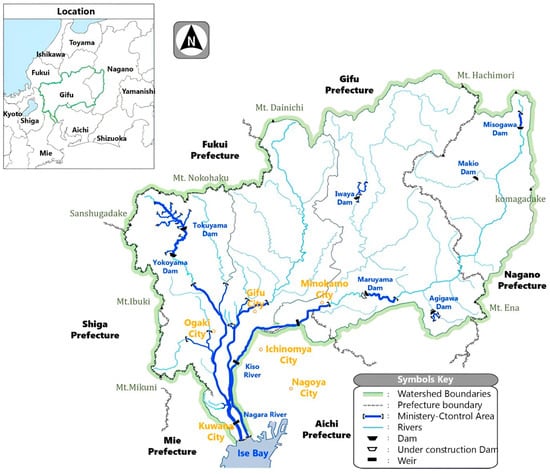
Figure 1.
Kiso River Watershed map (source: Ministry of Land, Infrastructure, Transport and Tourism).
2.2. Water Quality Parameters
The City of Nagoya’s Water and Sewerage Bureau provided hourly water quality data from 2016 to 2023. Climate data were selected to ensure alignment with the range of water quality data. The initial examination identified two monitoring stations in central Japan: Gifu Imato (35.4358° N, 137.0333° E) and Nagano Momoyama (35.7617° N, 137.7039° E), with Nagano Momoyama located northeast of Gifu Imato. The data from these stations are part of the Hydrological and Water Quality Dataset managed by the Water Management and National Land Conservation Bureau within the Ministry of Land, Infrastructure, Transport and Tourism (MLIT) of Japan. Specifically, it is a portal providing in situ measurements of water flow (level) and rainfall from 2016 to 2023. This study also incorporated air temperature data from the closest available monitoring station to further enhance the analysis. The water quality dataset from the City of Nagoya Water and Sewerage Bureau variables included basic physicochemical parameters, which are turbidity (NTU), water temperature, electrical conductivity (EC, μS/cm), pH, DO (mg/L), ammonia (mg/L), cyanide (mg/L), and organic pollution (mg/L). These parameters were primarily selected because of the availability of consistent, reliable measurements. In addition, these parameters are able to indicate pollution and potential risks to human health and ecosystems [33,34,35].
Meteorological air temperature data (2016–2023) were extracted from the Japan Meteorological Agency website. Similarly, hourly rainfall and river flow data during the same period were extracted from the Japan Ministry of Land, Infrastructure, Transport and Tourism website. The Python’s BeautifulSoup4 (the 2022 version) library was used to automate raw data extraction from various sources [36].
Time Series Decomposition
The 2016–2023 water quality time series captured consistent seasonal patterns (Figure 2). These seasonal patterns align with the aim of the study; thus, the dataset is representative of the seasonal trends providing consistent modeling. In addition, the analysis trend decreased during the COVID-19 pandemic period (2020–2021), likely due to reductions in industrial activity, tourism, and transportation, as well as improved water quality.
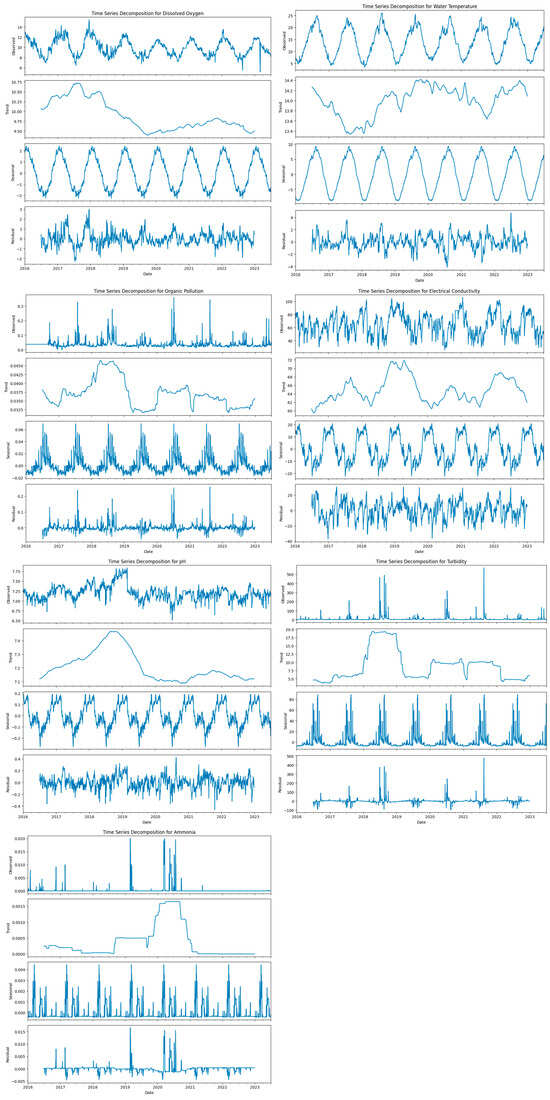
Figure 2.
Time series decomposition of water quality parameters.
Additionally, the residuals indicate a few episodic spikes in ammonia, turbidity, and pH, indicating limited data homogeneity in these parameters.
2.3. Seasonal Variation of Hydrological and Climatic Data
Seasonal variations in river flow, rainfall, and air temperature have significant impacts on water quality [29,37]. Understanding these variations is important for understanding their influence on water quality [38,39,40]. Analyzing seasonal patterns is also essential for interpreting model performance. Table 1 summarizes the seasonal and transitional periods in Japan and their characteristics [41]. To simplify the interpolation of the results, seasons were categorized as winter (December, January, and February), spring (March, April, and May), summer (June, July, and August), and fall (September, October, and November) based on average hourly values from 2016 to 2023.

Table 1.
Seasonal and transitional periods in Japan.
2.3.1. Seasonal Variation in River Flow
The river flow data analysis revealed higher values across all seasons for Momoyama. For instance, for fall, the Momoyama mean flow equals 8.99 m3/s compared to 2.59 m3/s at Imato. Considering the variability in the standard deviations, Imato exhibited higher variability, particularly in fall (2.61) and winter (2.57). Figure 3 shows the seasonal variations in river flow at the two locations.
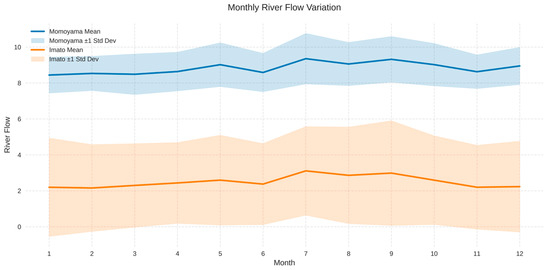
Figure 3.
Seasonal variation in river flow at Momoyama and Imato.
2.3.2. Seasonal Variation in Rainfall
Rainfall analysis revealed patterns of seasonal variation with the highest means in summer for both monitoring stations. The standard deviations for summer were large compared with the means of other seasons; this high variability could be explained by extreme events. Figure 4 shows high rainfall during the fall months. The statistical distribution of the standardized rainfall values showed lower bounds below zero owing to high variability.
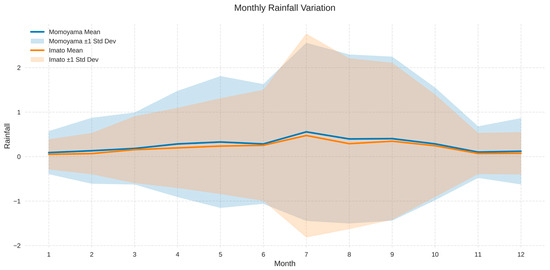
Figure 4.
Seasonal variation in rainfall at Momoyama and Imato.
2.3.3. Seasonal Variation in Air Temperature
Figure 5 shows the seasonal variation in air temperature, with the highest and lowest mean temperatures for summer and winter, respectively. Standard deviations were slightly higher across all seasons, particularly in spring and fall, indicating significant seasonal variability.
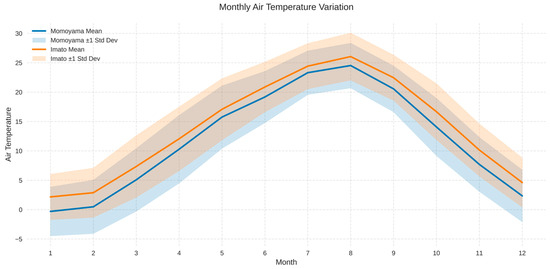
Figure 5.
Seasonal variation in air temperature at Momoyama and Imato.
2.4. Pre-Processing of Data
Extract-transform-load (ETL) processes used in data integration are shown in Figure 6 [42]. Raw data were extracted from different sources, transformed into a standardized format, and loaded into one dataset. The combined data contained missing values, outliers, and irrelevant data that could compromise the integrity and validity of the research findings. Thus, preprocessing techniques were used to address the missing data to ensure the integrity and reliability of the analyses [43]. Outlier detection was first performed on rainfall and river flow data to address negative values and was replaced with mean imputation. Seasonal imputation was used to fill in the missing November 2020 water quality data based on the periodic fluctuations of 2016, 2017, 2018, and 2019. Because cyanide was consistently measured to be zero, it was not detected in the water samples. Accordingly, it was excluded from the dataset as it was considered irrelevant to the research.
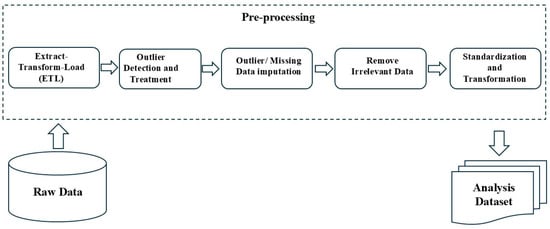
Figure 6.
Data pre-processing.
2.5. Statistical Analysis
2.5.1. Descriptive Statistics
Descriptive statistics were calculated to summarize and present the key features of the dataset. Key metrics such as minimum, maximum, standard deviations, and percentiles for climate and water quality parameters were assessed to provide an overview of the data characteristics using basic statistical calculations [44].
2.5.2. Correlation Analysis
The Pearson and Spearman correlation coefficients describe the complex interactions between climate and water quality parameters. Heatmaps were generated using Python 3.10 to visualize the interdependencies among parameters [45].
2.5.3. Generalized Additive Model (GAM)
The GAM is a powerful statistical analysis model that provides a deep understanding of complex data relationships [46]. It is particularly effective in estimating flexible and nonlinear trends in water quality monitoring [47,48,49] and highlighting the intricate dynamics of water quality parameters. The generalized additive model (GAM) used in this study is represented as follows:
where the following definitions apply:
- is the dependent variable;
- β is recognized as any strictly parametric component;
- are smooth function notations;
- εi is a normal random variable.
2.5.4. Model Validation
K-fold cross-validation is a technique used to evaluate performance and reduce overfitting. Figure 7 shows how the data were randomly split into k-folds, using each fold as a test set, while the remaining folds were used for training [50,51].
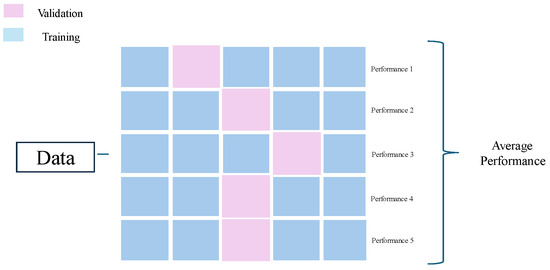
Figure 7.
Non-seasonal k-fold cross-validation.
Studies have discussed how seasonal variation has a significant effect on water quality. Thus, the dataset was split by season, the dataset was split by season (winter, spring, summer, fall), and then k-fold cross-validation was performed within the seasonal data (Figure 8).
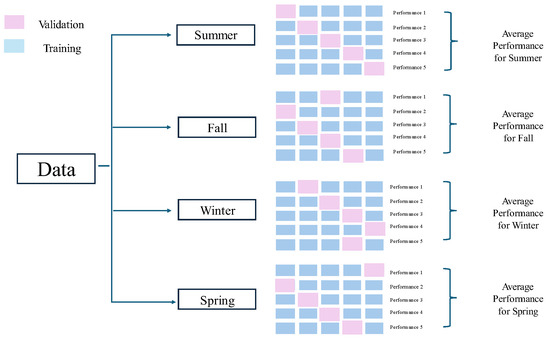
Figure 8.
Seasonal k-fold cross-validation.
2.5.5. Evaluation Metrics
Model evaluation is an essential step in ensuring accurate model prediction [52,53]. The model performance metrics include the mean squared error (MSE) (Equation (3)), root mean square error (RMSE) (Equation (4)), mean absolute error (MAE) (Equation (2)), and R squared (R2) (Equation (5)), which have been used in previous studies [54,55]. The performance indicators were computed using the following equation:
where the following definitions apply:
- = predicted value of ;
- = mean value of
3. Results and Discussion
3.1. Statistical Summary of Water Quality Parameters
A descriptive analysis of the water quality is presented in Table 2. The significant variance between the minimum and maximum turbidity values suggested that turbidity is correlated with extraordinary events such as floods [56]. In contrast, organic pollution and pH exhibited low variability, indicating regulated inputs from agricultural runoff, industrial discharge, or natural processes [57]. Ammonia levels remained undetectable with occasional increases, emphasizing the effectiveness of policy and management strategies in controlling agricultural runoff and industrial activities [58,59]. Despite the minimum DO levels (almost zero), historical data indicated the existence of isolated events with outlier values. Thus, the 75th percentile of DO at 11.22 mg/L suggested good oxygenation conditions for most of the data. The pH results suggested highly stable conditions that could be linked to human intervention to maintain ideal water quality.

Table 2.
The summary statistics of water quality parameters.
3.2. Correlation Analysis Results
Pearson’s correlation was used to assess linear relationships, whereas Spearman’s correlation was used to identify potential nonlinear trends. Turbidity showed a weak correlation with most of the variables except for organic pollution (Pearson’s r = 0.71), indicating a strong positive correlation. The linear relationship between turbidity and organic pollution has been well-established in research studies considering turbidity as an indicator of organic pollution [60,61,62]. A negative correlation was observed between EC and turbidity with Pearson’s r = −0.31 (Figure 9) and Spearman’s ρ = −0.72 (Figure 10), implying nonlinear linkage. This could be due to rainfall diluting the ionic concentration in the water, decreasing the EC and increasing the solid particle suspension, leading to higher turbidity [63]. This relationship could be positive if there were more conductive sediments [64]. Notably, the water temperature was inversely correlated with DO in both the Pearson (r = −0.89) and the Spearman correlation (ρ = −0.919). This inverse relationship is due to the decrease in oxygen solubility due to temperature [13,14,65,66]. However, water temperature was positively correlated with air temperature, which aligns with previous studies showing that changes in air temperature lead to corresponding changes in water temperature [13,14,65,66,67,68].
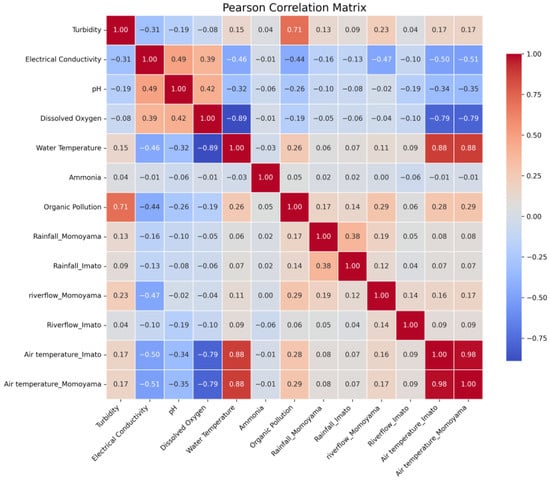
Figure 9.
Pearson correlation matrix.
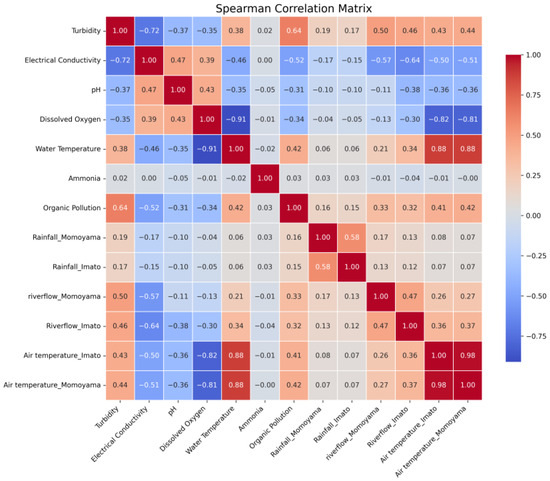
Figure 10.
Spearman correlation matrix.
The river flow in Momoyama showed moderate correlations with turbidity and organic pollution, presenting river flow as a possible indicator influencing the transport of suspended solids and directly affecting turbidity and organic pollution levels. In contrast, rainfall exhibited weak correlations with all water quality parameters. Rainfall mobilizes nutrients and pollutants [69] and dilutes the nutrient concentrations [70,71], leading to changes in water quality. The effect of rainfall on water quality parameters could be minimal due to flood-control measures [72].
3.3. General Additive Model (GAM)
We assessed the performance of the GAM in predicting water quality parameters using climatic and hydrological data, namely rainfall, river flow, and air temperature following k-fold cross-validation. Table 3 summarizes the performance of each target parameter using the full dataset without seasonal considerations. Table 4 summarizes the performance of each target parameter across the four seasons.

Table 3.
Non-seasonal cross-validation results for water quality parameters.

Table 4.
Cross-validation results for water quality parameters by season.
3.3.1. Turbidity
The seasonal turbidity model (Table 4) showed improvement during winter with R2 = 0.5030 compared to the non-seasonal model (Table 3) (R2 = 0.1470), implying greater accuracy with relatively smaller errors of MSE = 4.9348, RMSE = 2.2197, and MAE = 1.0713 (Figure 11). The model improvement can be justified by the generally stable hydrological conditions in winter, conditioned by low rainfall, river flow, and cold temperatures (see Figure 3, Figure 4 and Figure 5). In contrast, seasonal models declined in spring (R2 = 0.0991), summer (R2 = 0.1364), and fall (R2 = 0.2414) due to rainy and transitional periods with varying degrees of precipitation, runoff, and biological activity (Table 1). In addition, tidal dynamics and algal blooms primarily influence turbidity during summer [73,74], whereas agricultural runoff along with seasonal rainfall is a major driver of turbidity during fall and spring [75,76]. Conversely, winter has relatively stable hydrological conditions (Figure 9) and low turbidity levels, which likely enhanced the model’s accuracy. Therefore, incorporating event-driven predictors, such as rainfall intensity, storm frequency, and land runoff, can significantly improve model predictability for other seasons as well. Although seasonal characteristics vary across regions, similar turbidity trends have been observed in regional studies. In the Ichamati River, India, turbidity reached 700 NTU during monsoon season, due to the increase in sediment load [77]. In Lake Bosomtwe, Ghana, higher turbidity, total suspended solids (TSS), and nutrient concentrations were recorded during the wet season, largely attributed to increased runoff and anthropogenic activities [78]. Similarly, peak rainfall and land runoff in the Zigi River, Northern Tanzania, and the River Benue, Nigeria, during the wet season, elevated suspended solids, resulting in higher turbidity [79,80]. Thus, the seasons characterized by high variability in rainfall, river flow, and other environmental dynamics —namely fall, spring, and summer in this study—present challenges for accurate turbidity modeling.
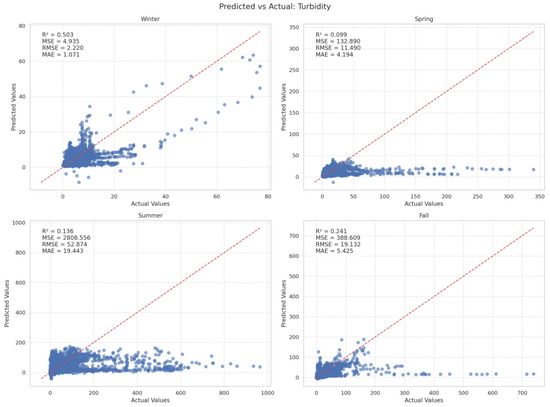
Figure 11.
Actual vs. predicted values of turbidity (NTU).
3.3.2. Electrical Conductivity (EC)
The non-seasonal EC model achieved an R2 value of 0.7385, MSE of 71.3241, RMSE of 8.4451, and MAE of 6.1867, indicating a good fit with a moderate prediction error. These values indicate that the model has a moderate ability to capture EC levels throughout the year, which aligns with the strong correlations between river flow and air temperature displayed in the correlation matrix (Figure 9 and Figure 10). Seasonal modeling showed a slightly stronger performance during fall (R2 value of 0.7737) and summer (R2 value of 0.7594) (Figure 12), with summer showing the least error. In the fall, cooling temperatures increase water viscosity, which reduces ion mobility and subsequently lowers the EC of water [81,82]. This stabilization of ionic mobility can also exist in a temperature-regulated environment [83,84,85]. The winter and spring models exhibited R2 values of 0.6603 and 0.6446, respectively. In Japan, cold weather and snowfall during winter (Table 1) cause delayed snowmelt, which affects ion mobility and makes it difficult to achieve accuracy [86]. Spring is a transitional season leading to warmer weather (Table 1) with fluctuating temperatures, atmospheric pressure, and winds. The complexity of these hydrological changes during spring and winter leads to lower model accuracy compared to the rest of the year. Similarly, in many regions, winter is associated with lower discharge, lower temperatures, and reduced biological activity, which lead to more stable changes in EC [87,88,89]. Spring, on the other hand, is characterized by increasing temperatures, snowmelt, and the resumption of biological activity. A study made in the River Jhelum Basin in the Kashmir Himalaya revealed the significant effect of spring dynamics on the ionic balance [90].

Figure 12.
Actual vs. predicted values of electrical conductivity (EC, μS/cm).
3.3.3. pH and Dissolved Oxygen (DO)
Non-seasonal pH (R2 = 0.3103, MSE = 0.0289, RMSE = 0.1699, MAE = 0.1336) and DO (R2 = 0.6145, MSE = 1.0058, RMSE = 1.0029, MAE = 0.7619) showed low predictive power for both models (Figure 12). Additionally, the seasonal models showed considerable variation, with R2 values ranging from (R2 = 0.3727) in winter to (R2 = 0.126) in spring, suggesting poor predictability of the pH models for all seasons. Similarly, the seasonal DO models showed low performance in spring (R2 = 0.180) and winter (R2 = 0.136), with slight improvements in fall (R2 = 0.551) and summer (R2 = 0.347).
Despite the high negative correlation between DO and air temperature for both the Spearman (r = −0.82/0.81) and the Pearson correlation (ρ = −0.79), the model prediction for seasonal DO remained low with slight seasonal improvement, particularly in fall (Figure 13). This suggests that low temperatures reduce biological activity, demonstrating the dominant role of air temperature. However, in winter, reduced sunlight and limited reaeration processes may have introduced variability, leading to poor model performance despite the cold conditions [91].
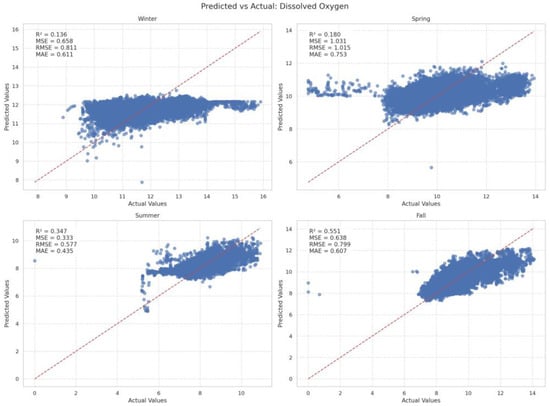
Figure 13.
Actual vs. predicted values of dissolved oxygen (DO, mg/L).
As expected, pH was more strongly correlated with air temperature (Figure 8 and Figure 9). Winter and fall seasonal models suggested better performance, with R2 = 0.3727 for winter and R2 = 0.3035 for fall (Figure 14). These results suggest that colder temperatures decrease the biological activity, resulting in more consistent pH levels [92,93]. In contrast to the fall and winter season, the elevated biological activity in summer led to lower pH stability [94]. A study made in major rivers of Uttar Pradesh, India, found that pH remains relatively stable in winter, aligning with the results presented in this study. Dissolved oxygen (DO) is elevated due to colder water temperatures in winter, introducing less stability compared to pH [95].
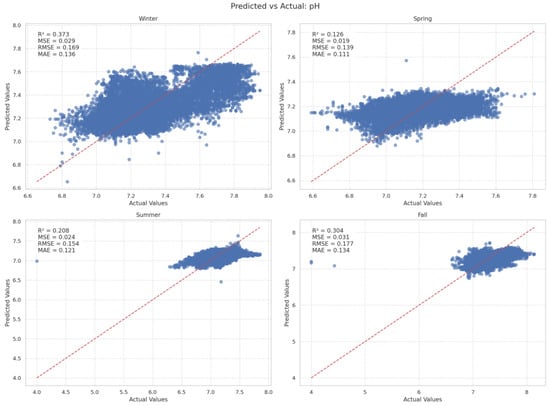
Figure 14.
Actual vs. predicted values of pH.
Transitional dynamics and snowmelt inputs in spring (Table 1) can cause fluctuations in pH, leading to low prediction power [96].
3.3.4. Water Temperature
The non-seasonal water temperature model, with an R2 value of 0.7365, provided better results, suggesting a strong fit with a relatively low prediction error. Although air and water temperatures were significantly correlated (Figure 8 and Figure 9), the winter model (Figure 15) showed low performance (R2 = 0.2531). Previous research has discussed that ice cover and reduced solar radiation during winter can limit the effects of air temperature on water temperature, leading to an unstable relationship [97,98]. Stable atmospheric conditions with low hydrological variability in fall resulted in the highest R2 value (0.7034). Spring and summer showed moderate model performance, with R2 values of 0.4277 and 0.5091, respectively, suggesting the impact of transitional snowmelt in spring [99] and hot conditions in summer [100].
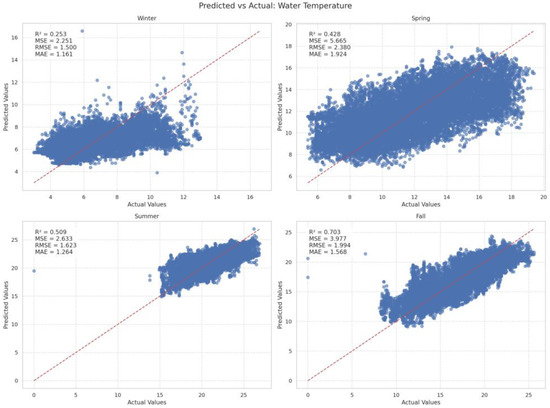
Figure 15.
Actual vs. predicted values of water temperature (°C).
3.3.5. Ammonia and Organic Pollution
Seasonal models for ammonia scored R2 values ranging from 0.0026 to 0.299, while those for organic pollution ranged from 0.1193 to 0.266, revealing weak predictive powers similar to those of the non-seasonal models (Figure 16 and Figure 17). Although rainfall, river flow, air temperature, and seasonality are natural drivers of water quality parameters such as ammonia and organic pollution [101,102], this study revealed that the models failed to predict these parameters without accounting for additional factors such as agricultural practices [103], urbanization and industrial activities [104], land use and land cover [104,105] and pollution control measures [106].
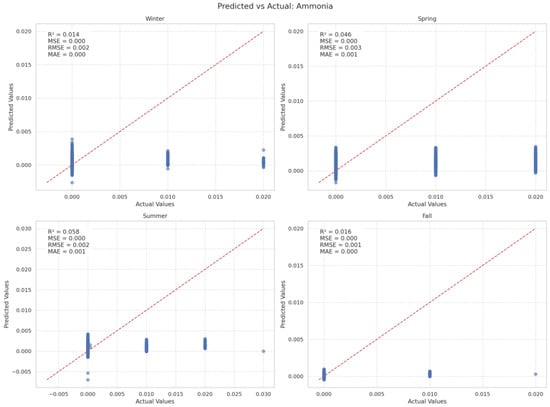
Figure 16.
Actual vs. predicted values of ammonia (mg/L).
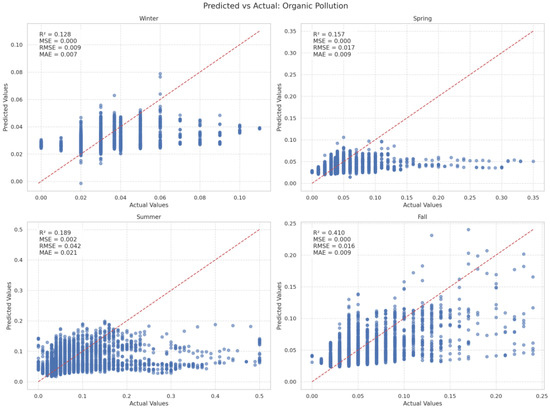
Figure 17.
Actual vs. predicted values of organic pollution (mg/L).
A study made on urban rivers in Tianjin, China, highlighted the importance of incorporating land use changes, urban point-source, anthropogenic activities, and surface runoff in models to capture changes in dissolved organic matter [107,108]. Similarly, advanced models used in the Middle-Lower Yangtze River, China, proved that limited monitoring and unclear spatiotemporal distribution of pollution sources affect the prediction accuracy of pollution loads [108] Thus, the weak predictive accuracy for ammonia and organic pollutants may be attributed to the influence of local sources and interactions not captured due to data limitations.
4. Conclusions
This study highlights the implications of considering seasonal variability in water quality assessments and their effects on model predictive performance. Focusing on physicochemical parameters such as temperature, turbidity, EC, pH, DO, and ammonia, this study showed how parameter responses across seasons were influenced by climatic and hydrological factors such as rainfall, temperature, and river flow. These findings support the development of season-specific models for a more informed monitoring and intervention in data-scarce regions. This can be achieved by investigating high-risk periods, improving infrastructure, and prioritizing monitoring plans, even with limited data.
A key limitation of this study is the lack of data on factors related to meteorology, groundwater, and human activities, which may limit model performance, especially for ammonia and organic matter. Additionally, rainfall, air temperature, and river flow data were collected from two monitoring stations along the river; therefore, site-specific differences might affect water quality parameters differently. To address these limitations, future work should aim to incorporate these factors to improve predictions. In addition, expanding data coverage for rainfall, air temperature, and river flow, as well as conducting long-term studies, will support the detection of climate-related trends. Lastly, the use of advanced modeling may further improve prediction performance.
In conclusion, seasonal analysis improves the prediction of water quality parameters when data availability is limited. Despite the limitations in data and model performance, the future development of integrated, high-resolution, and climate-informed models can inform policymakers and water resource managers, particularly in data-scarce areas.
Author Contributions
Conceptualization, O.M. and N.H.; methodology, O.M. and N.H.; formal analysis, O.M.; writing—original draft preparation, O.M.; writing—review and editing, O.M. and N.H.; visualization, O.M.; supervision, N.H. All authors have read and agreed to the published version of the manuscript.
Funding
This research was funded by the Environmental Research and Technology Development Fund (JPMEERF20S11816) of the Environmental Restoration and Conservation Agency of Japan.
Data Availability Statement
Meteorological data for air temperature presented in the study are openly available from the Japan Meteorological Agency (JMA) (www.data.jma.go.jp/). Similarly, rainfall and river flow data are available from the Japan Ministry of Land, Infrastructure, Transport and Tourism Restrictions apply to the availability of water quality data.
Acknowledgments
This study was supported by the Environmental Research and Technology Development Fund (JPMEERF20S11816) of the Environmental Restoration and Conservation Agency of Japan. We also extend our gratitude to the City of Nagoya Water and Sewerage Bureau for providing valuable raw water quality data.
Conflicts of Interest
The authors declare no conflicts of interest.
References
- Ding, J. Factors Affecting Water Quality in the Liao River Basin. In Highlights in Science, Engeneering and Tehnology; Darcy & Roy Press: Hillsboro, OR, USA, 2024; Volume 2023. [Google Scholar]
- Mamun, M.; Kim, J.Y.; Kim, J.E.; An, K.G. Longitudinal Chemical Gradients and the Functional Responses of Nutrients, Organic Matter, and Other Parameters to the Land Use Pattern and Monsoon Intensity. Water 2022, 14, 237. [Google Scholar] [CrossRef]
- Bessa Santos, R.M.; Farias do Valle, R., Jr.; Abreu Pires de Melo Silva, M.M.; Tarlé Pissarra, T.C.; Carvalho de Melo, M.; Valera, C.A.; Leal Pacheco, F.A.; Sanches Fernandes, L.F. A framework model to integrate sources and pathways in the assessment of river water pollution. Environ. Pollut. 2024, 347, 123661. [Google Scholar] [CrossRef] [PubMed]
- Surendra, P.; Saurabh, A.H. Impact Analysis of Urbanization and Industrialization on Water Quality of Vrishabhavathi River. Geogr. Anal. 2021, 10, 45–51. [Google Scholar] [CrossRef]
- Anh, N.T.; Can, L.D.; Nhan, N.T.; Schmalz, B.; Luu, T.L. Influences of key factors on river water quality in urban and rural areas: A review. Case Stud. Chem. Environ. Eng. 2023, 8, 100424. [Google Scholar] [CrossRef]
- Sani, Z.; Tshimanga, R.M.; Odume, O.N.; Basamba, T.A.; Katshiatshia, H.M. Developing an approach for balancing water use and protecting water quality of an urban river ecosystem. Phys. Chem. Earth 2024, 136, 103687. [Google Scholar] [CrossRef]
- Laura, K.S.H. Surface Water Quality Changes of River Reaches Due to Urbanization. In Proceedings of the in Water Resources and Wetlands Conference, Tulcea, Romania, 14–16 September 2012; Transversal: Viena, Austria, 2012. [Google Scholar]
- Quadir, A. Urbanization and its Impact on Ganga Basin. Int. J. Sci. Res. Publ 2022, 12, 371. [Google Scholar] [CrossRef]
- Wu, J.; Qin, C.X.; Yue, Y.; Cheng, S.P.; Zeng, H.; He, L.Y. Comprehensive effects of climate, land use/cover and management practices on runoff and nutrient variations in a rapidly urbanizing watershed. Chemosphere 2024, 349, 140934. [Google Scholar] [CrossRef]
- Schaffer-Smith, D.; DeMeester, J.E.; Tong, D.; Myint, S.W.; Libera, D.A.; Muenich, R.L. Landscape Pollution Source Dynamics Highlight Priority Locations for Basin-Scale Interventions to Protect Water Quality Under Hydroclimatic Variability. Earths Future 2023, 11, e2022EF003137. [Google Scholar] [CrossRef]
- Tong, S.T.Y.; Liu, A.J.; Goodrich, J.A. Climate Change Impacts on Nutrient and Sediment Loads in a Midwestern Agricultural Watershed. J. Environ. Inform. 2007, 9, 18–28. [Google Scholar] [CrossRef]
- Ducharne, A. Hydrology and Earth System Sciences Importance of stream temperature to climate change impact on water quality. Hydrol. Earth Syst. Sci. 2008, 12, 797–810. [Google Scholar] [CrossRef]
- Ficklin, D.L.; Stewart, I.T.; Maurer, E.P. Effects of climate change on stream temperature, dissolved oxygen, and sediment concentration in the Sierra Nevada in California. Water. Resour. Res. 2013, 49, 2765–2782. [Google Scholar] [CrossRef]
- Rajesh, M.; Rehana, S. Impact of climate change on river water temperature and dissolved oxygen: Indian riverine thermal regimes. Sci. Rep. 2022, 12, 9222. [Google Scholar] [CrossRef] [PubMed]
- Morrill, J.C.; Bales, R.C.; Conklin, M.H. Estimating Stream Temperature from Air Temperature: Implications for Future Water Quality. J. Environ. Eng. 2005, 131, 139–146. [Google Scholar] [CrossRef]
- Li, H.Y.; Xu, J.; Xu, R.Q. The effect of temperature on the water quality of lake. Adv. Mat. Res. 2013, 821, 1001–1004. [Google Scholar] [CrossRef]
- Dorado-Guerra, D.Y.; Paredes-Arquiola, J.; Pérez-Martín, M.Á.; Corzo-Pérez, G.; Ríos-Rojas, L. Effect of climate change on the water quality of Mediterranean rivers and alternatives to improve its status. J Environ. Manage. 2023, 348, 119069. [Google Scholar] [CrossRef]
- Liu, Y.; Guo, W.; Wei, C.; Huang, H.; Nan, F.; Liu, X.; Liu, Q.; Lv, J.; Feng, J.; Xie, J. Rainfall-induced changes in aquatic microbial communities and stability of dissolved organic matter: Insight from a Fen river analysis. Environ. Res. 2024, 246, 118107. [Google Scholar] [CrossRef]
- Ling, T.Y.; Soo, C.L.; Liew, J.J.; Nyanti, L.; Sim, S.F.; Grinang, J. Influence of rainfall on the physicochemical characteristics of a tropical river in Sarawak, Malaysia. Pol. J. Environ. Stud. 2017, 26, 2053–2065. [Google Scholar] [CrossRef] [PubMed]
- Juahir, H.; Ghazali, A.; Ismail, A.; Mohamad, M.; Hamzah, F.M.; Sudianto, S.; Sudianto, S.; Lokman, M.; Lasim, M.; Aidi Shahriz, M. The Assessment of Danau Kota Lake Water Quality Using Chemometrics Approach; IOP Conference Series: Materials Science and Engineering; Institute of Physics Publishing: Bristol, UK, 2019; Volume 621. [Google Scholar] [CrossRef]
- Whitehead, P.G.; Wilby, R.L.; Battarbee, R.W.; Kernan, M.; Wade, A.J. A review of the potential impacts of climate change on surface water quality. Hydrol. Sci. J. 2009, 54, 101–123. [Google Scholar] [CrossRef]
- Fant, C.; Srinivasan, R.; Boehlert, B.; Rennels, L.; Chapra, S.C.; Strzepek, K.M.; Corona, J.; Allen, A.; Martinich, J. Climate change impacts on us water quality using two models: HAWQS and US basins. Water 2017, 9, 118. [Google Scholar] [CrossRef]
- Gao, L.; Li, D. A review of hydrological/water-quality models. Front. Agric. Sci. Eng. 2014, 1, 267–276. [Google Scholar] [CrossRef]
- Khouloud, T.; Hedia, B.; Nissaf, B.-A.; Marc, S.; Dhafer, M.; Kouni, C.M. Comparative Performance Analysis for Generalized Additive and Generalized Linear Modeling in Epidemiology Methods of Evaluation for Modeling Disease Incidence. Int. J. Adv. Comput. Sci. App. 2017, 8, 418–423. [Google Scholar]
- Cho, J.; Shin, C.M.; Choi, H.K.; Kim, K.H.; Choi, J.Y. Development of an integrated method for long-term water quality prediction using seasonal climate forecast. Proc. Int. Assoc. Hydrol. Sci. 2016, 374, 175–185. [Google Scholar] [CrossRef][Green Version]
- Ahmadpour, A.; Mirhashemi, S.H.; Panahi, M. Comparative evaluation of classical and SARIMA-BL time series hybrid models in predicting monthly qualitative parameters of Maroon river. Appl. Water. Sci. 2023, 13, 71. [Google Scholar] [CrossRef]
- Jackson-Blake, L.A.; Clayer, F.; Haande, S.; Sample, J.E.; Moe, S.J. Seasonal forecasting of lake water quality and algal bloom risk using a continuous Gaussian Bayesian network. Hydrol. Earth. Syst. Sci. 2022, 26, 3103–3124. [Google Scholar] [CrossRef]
- Fleming, S.W.; Rittger, K.; Oaida Taglialatela, C.M.; Graczyk, I. Leveraging Next-Generation Satellite Remote Sensing-Based Snow Data to Improve Seasonal Water Supply Predictions in a Practical Machine Learning-Driven River Forecast System. Water. Resour. Res. 2024, 60, e2023WR035785. [Google Scholar] [CrossRef]
- Hammoumi, D.; Al-Aizari, H.S.; Alaraidh, I.A.; Okla, M.K.; Assal, M.E.; Al-Aizari, A.R.; Sheikh Moshab, M.; Chakiri, Z.; Bejjaji, Z. Seasonal Variations and Assessment of Surface Water Quality Using Water Quality Index (WQI) and Principal Component Analysis (PCA): A Case Study. Sustainability 2024, 16, 5644. [Google Scholar] [CrossRef]
- Kazuki, M. Recent Trend of Annual Precipitation and its Effect on River Water Quality: A Case Study. In Proceedings of the International Symposium on Hydrology Water Resources and Enviroment Delopment and Management in Southeast Asia and the Pacific, Taegu, Republic of Korea, 10–13 November 1998; Kyoto University Press: Kyoto, Japan, 1998; p. 319. [Google Scholar]
- Sugimoto, R.; Kasai, A.; Fujita, K.; Sakaguchi, K.; Mizuno, T. Assessment of nitrogen loading from the Kiso-Sansen Rivers into Ise Bay using stable isotopes. J. Oceanogr. 2011, 67, 231–240. [Google Scholar] [CrossRef]
- Takuro, K. The history of the Kiso River low water management Shigeki MATSUURA Water Science Published by Japan Forest Conservation Association. Water Sci. 2008, 51, 1–39. [Google Scholar] [CrossRef]
- Shrestha, S.; Kazama, F. Assessment of surface water quality using multivariate statistical techniques: A case study of the Fuji river basin, Japan. Environ. Model. Softw. 2007, 22, 464–475. [Google Scholar] [CrossRef]
- Ren, J.Y.; Liu, H.M.; Ding, S.Y.; Cao, Z.H. Spatio-Temporal Variation Characteristics of Water Quality and Its Response to Climate: A Case Study in Yihe River Basin. J. Environ. Inform. Lett. 2021, 6, 10–22. [Google Scholar] [CrossRef]
- Coletti, C.; Testezlaf, R.; Ribeiro, T.A.P.; De Souza, R.T.G.; Pereira, D.D.A. Water quality index using multivariate factorial analysis. Revista Bras. Eng. Agrícola Ambient. 2010, 14, 517–522. [Google Scholar] [CrossRef]
- Abodayeh, A.; Hejazi, R.; Najjar, W.; Shihadeh, L.; Latif, R. Web Scraping for Data Analytics: A BeautifulSoup Implementation. In Proceedings of the 2023 6th International Conference of Women in Data Science at Prince Sultan University, WiDS-PSU 2023, Riyadh, Saudi Arabia, 14–15 March 2023; Institute of Electrical and Electronics Engineers Inc.: New York, NY, USA, 2023; pp. 65–69. [Google Scholar] [CrossRef]
- Bourguignon, D.A.d.S.; Fraga, M.d.S.; Lyra, G.B.; Cecílio, R.A.; Abreu, M.C. Effect of rainfall seasonality and land use on the water quality of the Paraíba do Sul River. Rev. Eng. Na Agric. Reveng 2021, 29, 211–228. [Google Scholar] [CrossRef]
- Aliyu, A.G.; Jamil, N.R.B.; Adam, M.B.b.; Zulkeflee, Z. Spatial and seasonal changes in monitoring water quality of Savanna River system. Arab. J. Geosci. 2020, 13, 1–13. [Google Scholar] [CrossRef]
- Fan, X.; Cui, B.; Zhang, K.; Zhang, Z.; Shao, H. Water Quality Management Based on Division of Dry and Wet Seasons in Pearl River Delta, China. Clean 2012, 40, 381–393. [Google Scholar] [CrossRef]
- Hasson, S.; Lucarini, V.; Pascale, S.; Böhner, J. Seasonality of the hydrological cycle in major South and Southeast Asian river basins as simulated by PCMDI/CMIP3 experiments. Earth Syst. Dyn. 2014, 5, 67–87. [Google Scholar] [CrossRef]
- Hyoe, T. Four Seasons for Japan. In Proceedings of the General Meeting of the Association of Japanese Geographers Annual Meeting of the Association of Japanese Geographers; 2014. [Google Scholar] [CrossRef]
- Kamarthi, A. A Delve into the Implementation of Data Quality Framework on Very Large Databases. Interantional J. Sci. Res. Eng. Manag. 2024, 8, 1–5. [Google Scholar] [CrossRef]
- Smith, K.; Climer, S. Improving Data Cleaning Using Discrete Optimization 2024. arXiv 2024, arXiv:2405.00764. [Google Scholar]
- Talaat, H.; Blbas, A. Descriptive Statistics. Recent Advances in Biostatistics; IntechOpen: London, UK, 2024. [Google Scholar] [CrossRef]
- Dudáš, A. Graphical representation of data prediction potential: Correlation graphs and correlation chains. Vis. Comput. 2024, 40, 6969–6982. [Google Scholar] [CrossRef]
- Solonen, A.; Staboulis, S. On Bayesian Generalized Additive Models 2023. arXiv 2023, arXiv:2303.02626. [Google Scholar]
- Simpson, G.L. Modelling palaeoecological time series using generalised additive models. Front. Ecol. Evol. 2018, 6, 149. [Google Scholar] [CrossRef]
- Morton, R.; Henderson, B.L. Estimation of nonlinear trends in water quality: An improved approach using generalized additive models. Water. Resour. Res. 2008, 44. [Google Scholar] [CrossRef]
- Scholarsarchive, B.; Richards, R.G.; Tomlinson, R.; Chaloupka, M. Using Generalized Additive Models to Assess, Explore and Unify Environmental Monitoring Datasets. In Proceedings of the 5th International Congress on Environmental Modelling and Software, Ottawa, ON, Canada, 1 July 2010; IEMSs: Dublin, Ireland, 2010. [Google Scholar]
- Qiu, J. An Analysis of Model Evaluation with Cross-Validation: Techniques, Applications, and Recent Advances. Adv. Econ. Manag. Political Sci. 2024, 99, 69–72. [Google Scholar] [CrossRef]
- Bhagat, M.; Bakariya, B. A Comprehensive Review of Cross-Validation Techniques in Machine Learning. IJSAT-Int. J. Sci. Technol. 2025, 16, 1–4. [Google Scholar]
- Chicco, D.; Warrens, M.J.; Jurman, G. The coefficient of determination R-squared is more informative than SMAPE, MAE, MAPE, MSE and RMSE in regression analysis evaluation. Peer. J. Comput. Sci. 2021, 7, 1–24. [Google Scholar] [CrossRef] [PubMed]
- Plevris, V.; Solorzano, G.; Bakas, N.P.; Ben Seghier, M.E.A. Investigation of Performance Metrics in Regression Analysis and Machine Learning-Based Prediction Models. In Proceedings of the World Congress in Computational Mechanics and ECCOMAS Congress, Scipedia, Vancouver, BC, Canada, 21–26 July 2024; QSpace: London, UK, 2014. [Google Scholar] [CrossRef]
- Makumbura, R.K.; Mampitiya, L.; Rathnayake, N.; Meddage, D.P.P.; Henna, S.; Dang, T.L.; Hoshino, Y.; Rathnayake, U. Advancing water quality assessment and prediction using machine learning models, coupled with explainable artificial intelligence (XAI) techniques like shapley additive explanations (SHAP) for interpreting the black-box nature. Results Eng. 2024, 23, 102831. [Google Scholar] [CrossRef]
- Yang, S.; Liang, R.; Chen, J.; Wang, Y.; Li, K. Estimating the water quality index based on interpretable machine learning models. Water Sci. Technol. 2024, 89, 1340–1356. [Google Scholar] [CrossRef]
- Al Sawaf, M.B.; Kawanisi, K.; Bahreinimotlagh, M. Examining the Relationship between Rainfall, Runoff, and Turbidity during the Rainy Season in Western Japan. Geohazards 2024, 5, 176–191. [Google Scholar] [CrossRef]
- Wen, Y.; Schoups, G.; van de Giesen, N. Organic pollution of rivers: Combined threats of urbanization, livestock farming and global climate change. Sci. Rep. 2017, 7, srep43289. [Google Scholar] [CrossRef]
- Zhang, Q.; Hu, W.; Huang, G.; Lv, Z.; Liu, F. The characteristics of ammonia nitrogen in the Xiang river in Changsha, China. In Proceedings of the E3S Web of Conferences, Guangzhou, China, 18–20 December 2020; EDP Sciences: London, UK, 2021; Volume 233. [Google Scholar] [CrossRef]
- Hu, M. Spatiotemporal distribution and controlling factors on ammonium in waters in the central Yangtze River Basin, China. J. Contam. Hydrol. 2023, 258, 104239. [Google Scholar] [CrossRef]
- Baldwin, A.K.; Robertson, D.M.; Saad, D.A.; Magruder, C. Scientific Investigations Report 2013-5174 Prepared in cooperation with the Milwaukee Metropolitan Sewerage District. In Refinement of Regression Models to Estimate Real-Time Concentrations of Contaminants in the Menomonee River Drainage Basin, Southeast Wisconsin, 2008–2011; USGS: Reston, VA, USA, 2008. [Google Scholar]
- Kusari, L. Turbidity as a Surrogate for the Determination of Total Phosphorus, Using Relationship Based on Sub-Sampling Techniques. Ecol. Eng. Environ. Technol. 2022, 23, 88–93. [Google Scholar] [CrossRef]
- Rügner, H.; Schwientek, M.; Beckingham, B.; Kuch, B.; Grathwohl, P. Turbidity as a proxy for total suspended solids (TSS) and particle facilitated pollutant transport in catchments. Environ. Earth Sci. 2013, 69, 373–380. [Google Scholar] [CrossRef]
- Bersinger, T.; Le Hécho, I.; Bareille, G.; Pigot, T.; Lecomte, A. Continuous Monitoring of Turbidity and Conductivity in Wastewater Networks. Rev. des Sci. de l’eau 2015, 28, 9–17. [Google Scholar] [CrossRef][Green Version]
- Batina, A.; Krtalić, A. Integrating Remote Sensing Methods for Monitoring Lake Water Quality: A Comprehensive Review. Hydrology 2024, 11, 92. [Google Scholar] [CrossRef]
- Trombetta, T.; Vidussi, F.; Mas, S.; Parin, D.; Simier, M.; Mostajir, B. Water temperature drives phytoplankton blooms in coastal waters. PLOS 2019, 14, e0214933. [Google Scholar] [CrossRef]
- Fang, X.; Stefan, H.G. Simulations of climate effects on water temperature, dissolved oxygen, and ice and snow covers in lakes of the contiguous U.S. under past and future climate scenarios. Limnol. Oceanogr. 2009, 54, 2359–2370. [Google Scholar] [CrossRef]
- Adhar, S.; Mainisa; Andika, Y. Response of Water Temperature to Wind Speed and Air Temperature in Lake Laut Tawar, Aceh Province, Indonesia. J. Geosci. Eng. Environ. Technol. 2024, 9, 243–250. [Google Scholar] [CrossRef]
- Drainas, K.; Kaule, L.; Mohr, S.; Uniyal, B.; Wild, R.; Geist, J. Predicting stream water temperature with artificial neural networks based on open-access data. Hydrol. Process. 2023, 37, e14991. [Google Scholar] [CrossRef]
- Yuan, Y.; Liang, X.; Li, Q.; Deng, J.; Zou, J.; Li, G.; Chen, G.; Qin, W.; Dai, H. Response of a source water quality through a heavy precipitation event: Nutrients, dissolved organic matter and their DBPs formation. J. Clean. Prod. 2024, 453, 142273. [Google Scholar] [CrossRef]
- Tilahun, A.B.; Dürr, H.H.; Schweden, K.; Flörke, M. Perspectives on total phosphorus response in rivers: Examining the influence of rainfall extremes and post-dry rainfall. Sci. Total. Environ. 2024, 940, 173677. [Google Scholar] [CrossRef]
- Koushali, H.P.; Mastouri, R.; Khaledian, M.R. Impact of Precipitation and Flow Rate Changes on the Water Quality of a Coastal River. Shock. Vib. 2021, 2021, 6557689. [Google Scholar] [CrossRef]
- Nagayama, K.; Tonooka, H. Prediction of the Area of High-Turbidity Water in the Yatsushiro Sea, Japan, Using Machine Learning with Satellite, Meteorological, and Oceanographic Data. Remote. Sens. 2023, 15, 1652. [Google Scholar] [CrossRef]
- Indivero, J.; Myers-Pigg, A.N.; Ward, N.D. Seasonal Changes in the Drivers of Water Physico-Chemistry Variability of a Small Freshwater Tidal River. Front. Mar. Sci. 2021, 8, 607664. [Google Scholar] [CrossRef]
- Lee, B.J.; Hur, J.; Toorman, E.A. Seasonal Variation in Flocculation Potential of River Water: Roles of the Organic Matter Pool. Water 2017, 9, 335. [Google Scholar] [CrossRef]
- Cruz, M.A.S.; Gonçalves, A.d.A.; de Aragão, R.; de Amorim, J.R.A.; da Mota, P.V.M.; Srinivasan, V.S.; Garcia, C.A.B.; de Figueiredo, E.E. Spatial and seasonal variability of the water quality characteristics of a river in Northeast Brazil. Environ. Earth Sci. 2019, 78, 68. [Google Scholar] [CrossRef]
- Lenhart, C.F.; Brooks, K.N.; Heneley, D.; Magner, J.A. Spatial and temporal variation in suspended sediment, organic matter, and turbidity in a Minnesota prairie river: Implications for TMDLs. Environ. Monit. Assess. 2009, 165, 435–447. [Google Scholar] [CrossRef]
- Mondal, I.; Bandyopadhyay, J.; Paul, A.K. Water quality modeling for seasonal fluctuation of Ichamati river, West Bengal, India. Model. Earth Syst. Environ. 2016, 2, 1–12. [Google Scholar] [CrossRef]
- Owusu-Boateng, G.; Ampofo-Yeboah, A.; Agyemang, T.K.; Sarpong, K. Seasonal Variation in Water Quality Index of the Lake Bosomtwe Biosphere Reserve. Environ. Ecosyst. Sci. 2022, 6, 46–51. [Google Scholar] [CrossRef]
- Nyambukah, R.; Mihale, M.J. Seasonal Variability of Water Quality in the Zigi River, Northern Tanzania. Huria J. Open Univ. Tanzan. 2022, 28. [Google Scholar] [CrossRef]
- Adamu, A.B.; Torsabo, D.; Abubakar, K.A.; Ali, J. Seasonal Variation of Physicochemical Properties in the Lower River Benue, Nigeria. Asian J. Fish. Aquat. Res. 2024, 26, 164–181. [Google Scholar] [CrossRef]
- Rogacs, A.; Santiago, J.G. Temperature Effects on Electrophoresis. Anal. Chem. 2013, 85, 5103–5113. [Google Scholar] [CrossRef]
- Boroujeni, S.N.; Maribo-Mogensen, B.; Liang, X.; Kontogeorgis, G.M. New Electrical Conductivity Model for Electrolyte Solutions Based on the Debye–Hückel–Onsager Theory. J. Phys. Chem. B 2023, 127, 9954–9975. [Google Scholar] [CrossRef] [PubMed]
- Endoh, S.; Tsujii, I.; Kawashima, M.; Okumura, Y. A new method for temperature compensation of electrical conductivity using temperature-fold dependency of fresh water. Limnology 2008, 9, 159–161. [Google Scholar] [CrossRef]
- Zhang, X.-M.; Hu, Y.-F.; Peng, X.-M.; Yue, W.-J. Conductivities of Several Ternary Electrolyte Solutions and Their Binary Subsystems at 293.15, 298.15, and 303.15 K. J. Solut. Chem. 2009, 38, 1295–1306. [Google Scholar] [CrossRef]
- Anderko, A.; Lencka, M.M. Computation of Electrical Conductivity of Multicomponent Aqueous Systems in Wide Concentration and Temperature Ranges. Ind. Eng. Chem. Res. 1997, 36, 1932–1943. [Google Scholar] [CrossRef]
- Osterkamp, T.E.; Gilfilian, R.E.; Benson, C.S. Observations of stage, discharge, pH, and electrical conductivity during periods of ice formation in a small subarctic stream. Water Resour. Res. 1975, 11, 268–272. [Google Scholar] [CrossRef]
- Mir, R.A.; Jeelani, G.; Dar, F.A. Spatio-temporal patterns and factors controlling the hydrogeochemistry of the river Jhelum basin, Kashmir Himalaya. Environ. Monit. Assess. 2016, 188, 1–24. [Google Scholar] [CrossRef]
- Mei, K.; Liao, L.; Zhu, Y.; Lu, P.; Wang, Z.; Dahlgren, R.A.; Zhang, M. Evaluation of spatial-temporal variations and trends in surface water quality across a rural-suburban-urban interface. Environ. Sci. Pollut. Res. 2014, 21, 8036–8051. [Google Scholar] [CrossRef] [PubMed]
- Bhat, S.U.; Bhat, A.A.; Jehangir, A.; Hamid, A.; Sabha, I.; Qayoom, U. Water Quality Characterization of Marusudar River in Chenab Sub-Basin of North-Western Himalaya Using Multivariate Statistical Methods. Water, Air, Soil Pollut. 2021, 232, 1–22. [Google Scholar] [CrossRef]
- Khanday, S.A.; Bhat, S.U.; Islam, S.T.; Sabha, I. Identifying lithogenic and anthropogenic factors responsible for spatio-seasonal patterns and quality evaluation of snow melt waters of the River Jhelum Basin in Kashmir Himalaya. Catena 2021, 196, 104853. [Google Scholar] [CrossRef]
- Chapra, S.C.; Camacho, L.A.; McBride, G.B. Impact of Global Warming on Dissolved Oxygen and BOD Assimilative Capacity of the World’s Rivers: Modeling Analysis. Water 2021, 13, 2408. [Google Scholar] [CrossRef]
- Muth, A.F.; Kelley, A.L.; Dunton, K.H. High-frequency pH time series reveals pronounced seasonality in Arctic coastal waters. Limnol. Oceanogr. 2022, 67, 1429–1442. [Google Scholar] [CrossRef]
- Madkaiker, K.; Valsala, V.; Sreeush, M.G.; Mallissery, A.; Chakraborty, K.; Deshpande, A. Understanding the Seasonality, Trends, and Controlling Factors of Indian Ocean Acidification Over Distinctive Bio-Provinces. J. Geophys. Res. Biogeosciences 2023, 128, e2022JG006926. [Google Scholar] [CrossRef]
- Albuquerque, C.; Kerr, R.; Monteiro, T.; Orselli, I.B.M.; de Carvalho-Borges, M.; Carvalho, A.d.C.d.O.; Machado, E.d.C.; Mansur, J.K.; Copertino, M.d.S.; Mendes, C.R.B. Seasonal variability of carbonate chemistry and its controls in a subtropical estuary. Estuarine, Coast. Shelf Sci. 2022, 276, 108020. [Google Scholar] [CrossRef]
- Ghildyal, D.; Chaudhary, M. Seasonal Variations of pH and Dissolved Oxygen Concentrations in Major Rivers of Uttar Pradesh. J. Phys. Conf. Ser. 2023, 2570, 012013. [Google Scholar] [CrossRef]
- Liu, G.; He, W.; Cai, S. Seasonal Variation of Dissolved Oxygen in the Southeast of the Pearl River Estuary. Water 2020, 12, 2475. [Google Scholar] [CrossRef]
- Graf, R.; Wrzesiński, D. Detecting Patterns of Changes in River Water Temperature in Poland. Water 2020, 12, 1327. [Google Scholar] [CrossRef]
- Markovic, D.; Scharfenberger, U.; Schmutz, S.; Pletterbauer, F.; Wolter, C. Variability and alterations of water temperatures across the Elbe and Danube River Basins. Clim. Chang. 2013, 119, 375–389. [Google Scholar] [CrossRef]
- Michel, A.; Brauchli, T.; Lehning, M.; Schaefli, B.; Huwald, H. Stream temperature and discharge evolution in Switzerland over the last 50 years: Annual and seasonal behaviour. Hydrol. Earth Syst. Sci. 2020, 24, 115–142. [Google Scholar] [CrossRef]
- Seyedhashemi, H.; Vidal, J.-P.; Diamond, J.S.; Thiéry, D.; Monteil, C.; Hendrickx, F.; Maire, A.; Moatar, F. Regional, multi-decadal analysis on the Loire River basin reveals that stream temperature increases faster than air temperature. Hydrol. Earth Syst. Sci. 2022, 26, 2583–2603. [Google Scholar] [CrossRef]
- Ryan, K.A.; Garayburu-Caruso, V.A.; Crump, B.C.; Bambakidis, T.; Raymond, P.A.; Liu, S.; Stegen, J.C. Riverine dissolved organic matter transformations increase with watershed area, water residence time, and Damköhler numbers in nested watersheds. Biogeochemistry 2024, 167, 1203–1224. [Google Scholar] [CrossRef]
- Lambert, T.; Teodoru, C.R.; Nyoni, F.C.; Bouillon, S.; Darchambeau, F.; Massicotte, P.; Borges, A.V. Along-stream transport and transformation of dissolved organic matter in a large tropical river. Biogeosciences 2016, 13, 2727–2741. [Google Scholar] [CrossRef]
- Han, F.; Tian, Q.; Chen, N.; Hu, Z.; Wang, Y.; Xiong, R.; Xu, P.; Liu, W.; Stehr, A.; Barra, R.O.; et al. Assessing ammonium pollution and mitigation measures through a modified watershed non-point source model. Water Res. 2024, 254, 121372. [Google Scholar] [CrossRef]
- Bi, Z.; Zhang, Y.; Shi, P.; Zhang, X.; Shan, Z.; Ren, L. The impact of land use and socio-economic factors on ammonia nitrogen pollution in Weihe River watershed, China. Environ. Sci. Pollut. Res. 2021, 28, 17659–17674. [Google Scholar] [CrossRef] [PubMed]
- Cui, Y.; Wen, S.; Stegen, J.C.; Hu, A.; Wang, J. Chemodiversity of riverine dissolved organic matter: Effects of local environments and watershed characteristics. Water Res. 2023, 250, 121054. [Google Scholar] [CrossRef]
- Ma, L.; Pan, Y.; Wang, X.; Liu, G.; Liu, W. Discrepancy in Response of Complete Ammonia Oxidizers and Ammonia-Oxidizing Bacteria and Archaea in the Lhasa River to High-Elevation Conditions. ACS ES&T Water 2023, 3, 3357–3368. [Google Scholar] [CrossRef]
- Wen, Y.; Xiao, M.; Chen, Z.; Zhang, W.; Yue, F. Seasonal Variations of Dissolved Organic Matter in Urban Rivers of Northern China. Land 2023, 12, 273. [Google Scholar] [CrossRef]
- Wang, F.; Zhang, P.; Yan, W.; Jia, M.; Su, X.; Wang, J.; Tian, S. Riverine organic pollution source and yield from the whole Changjiang river network: Effects of urbanization under changing hydrology. J. Hydrol. 2023, 620, 129544. [Google Scholar] [CrossRef]
Disclaimer/Publisher’s Note: The statements, opinions and data contained in all publications are solely those of the individual author(s) and contributor(s) and not of MDPI and/or the editor(s). MDPI and/or the editor(s) disclaim responsibility for any injury to people or property resulting from any ideas, methods, instructions or products referred to in the content. |
© 2025 by the authors. Licensee MDPI, Basel, Switzerland. This article is an open access article distributed under the terms and conditions of the Creative Commons Attribution (CC BY) license (https://creativecommons.org/licenses/by/4.0/).